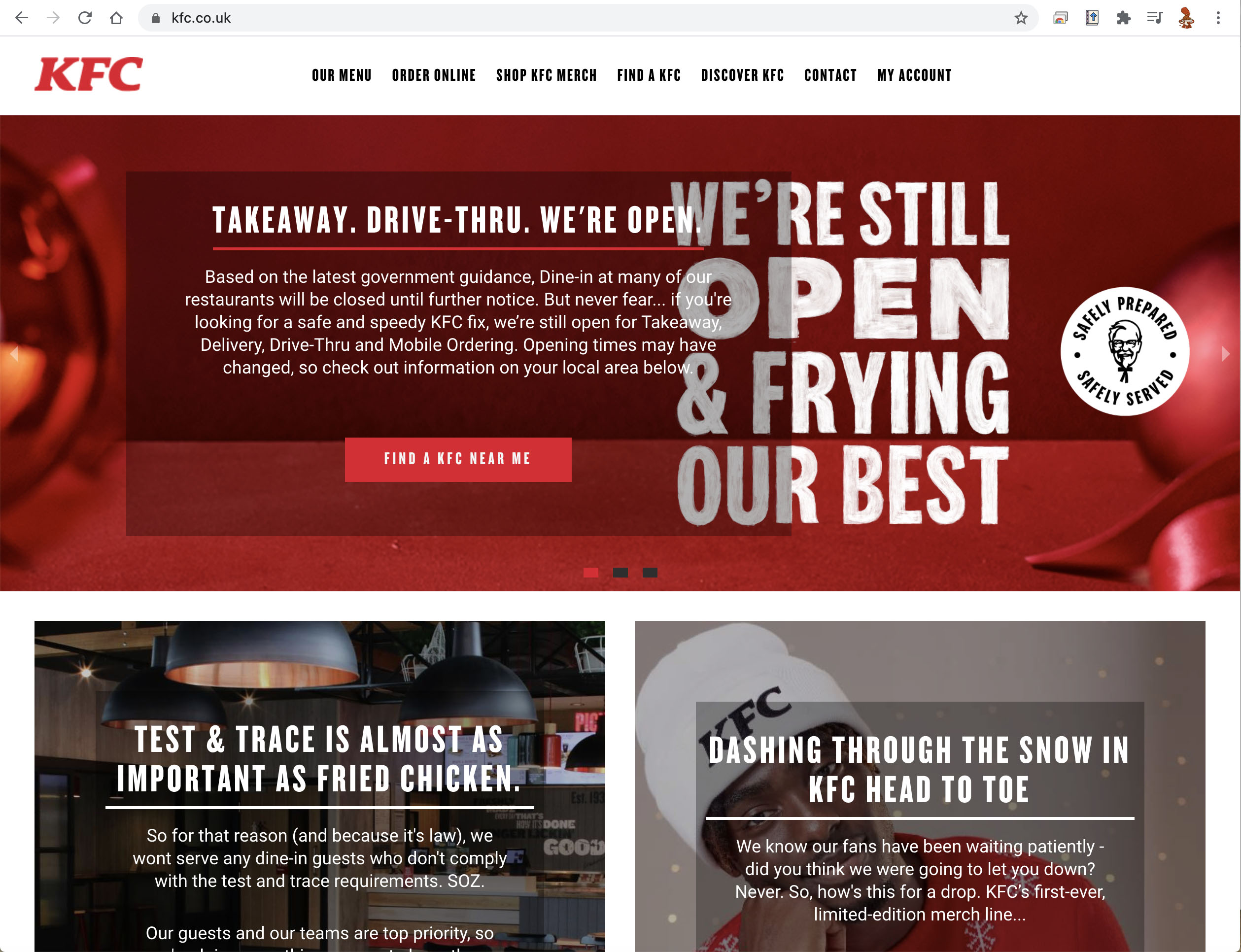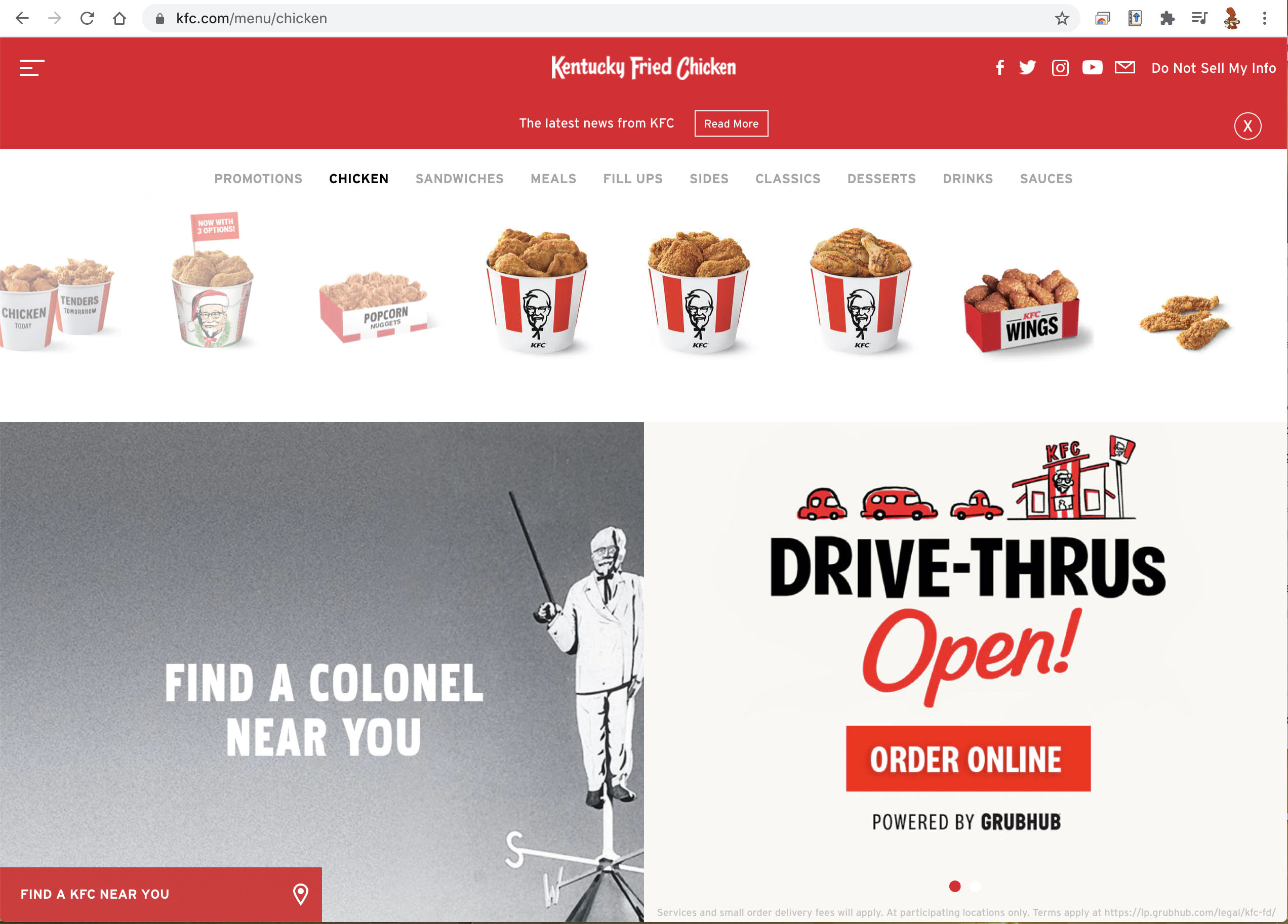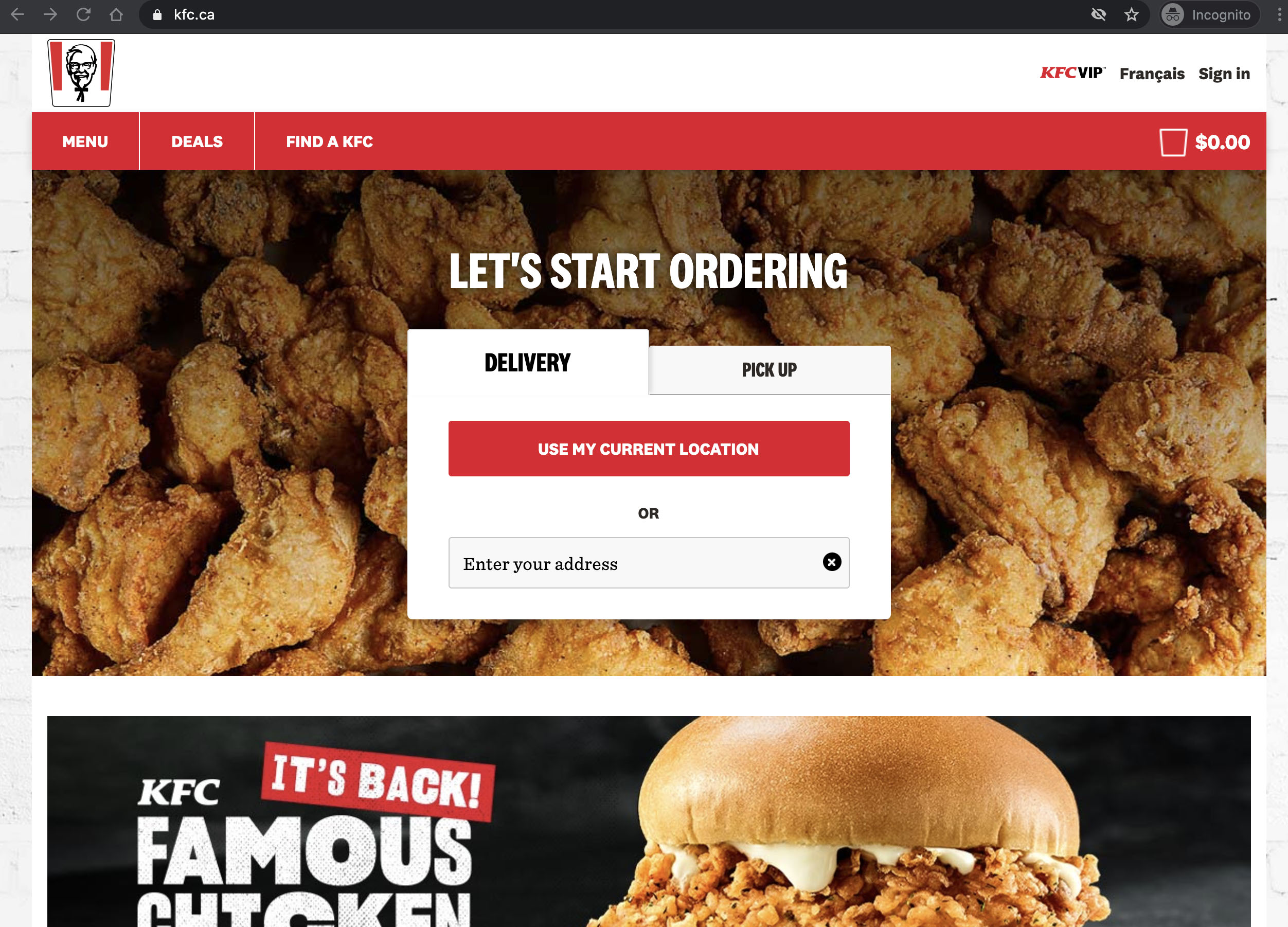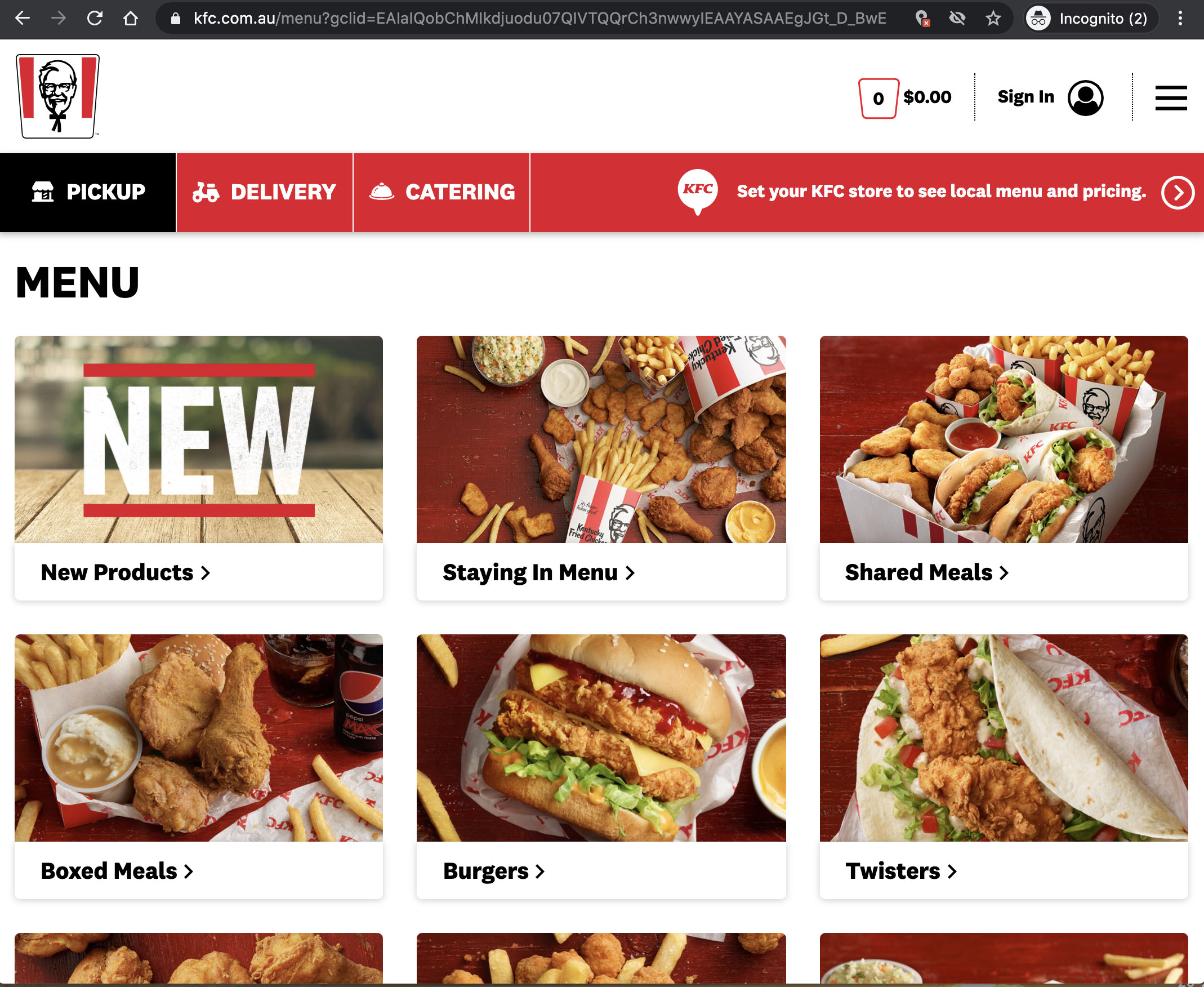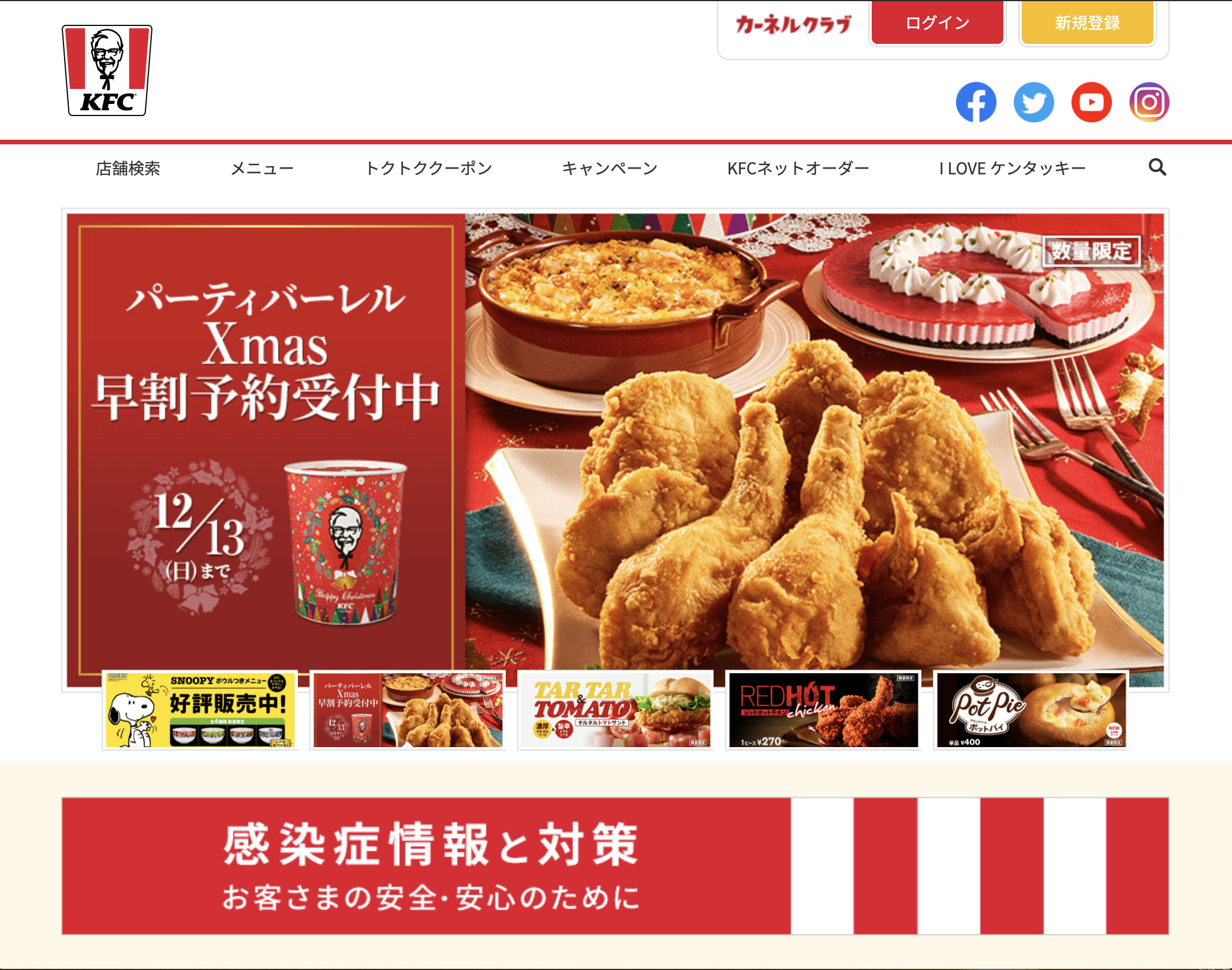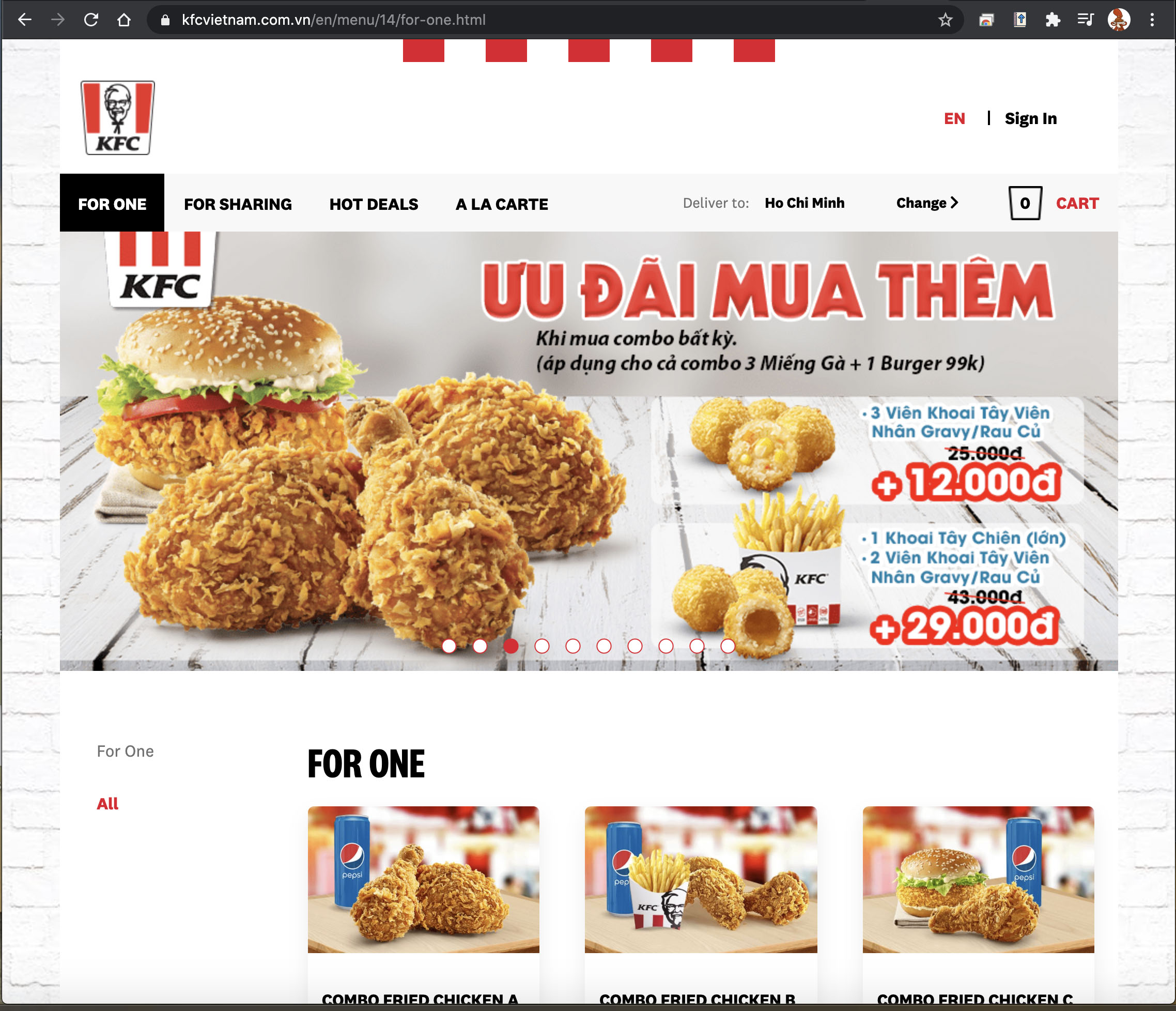Lecture with Martin Hosken
Lecture with Tom Finn
Communication lies at the heart of graphic design, but how can we communicate effectively? We take for granted that what we intend to communicate will be the message received, but this is not always the case. Communication is generally broken down into four main areas:
Verbal Communication
Non-Verbal Communication
Written Communication
Visual Communication
Design is often the combination of visual and written communication, using symbols and signs, text and image to indicate meaning. Symbols and signs make up the majority of human communication – letters and alphabets, typography, visual storytelling, all use symbols and signs. Unfortunately, they are meaningless of themselves and rely on culturally learned significance. (Hosken n.d.)
Cross-cultural communication can be very complex, learning the significance of most signs and symbols is an organic process we absorb as we grow. As we do not remember explicitly learning what body language, gestures and cultural subtext mean, we tend to assume that they are the same everywhere. Even non-verbal communication relies on gesture and body language that is not universal. This chart of hand gestures around the world illustrates different meanings across cultures. Being aware of cultural divides and context can the be the difference between insulting someone you meant to encourage, or appropriate communication.
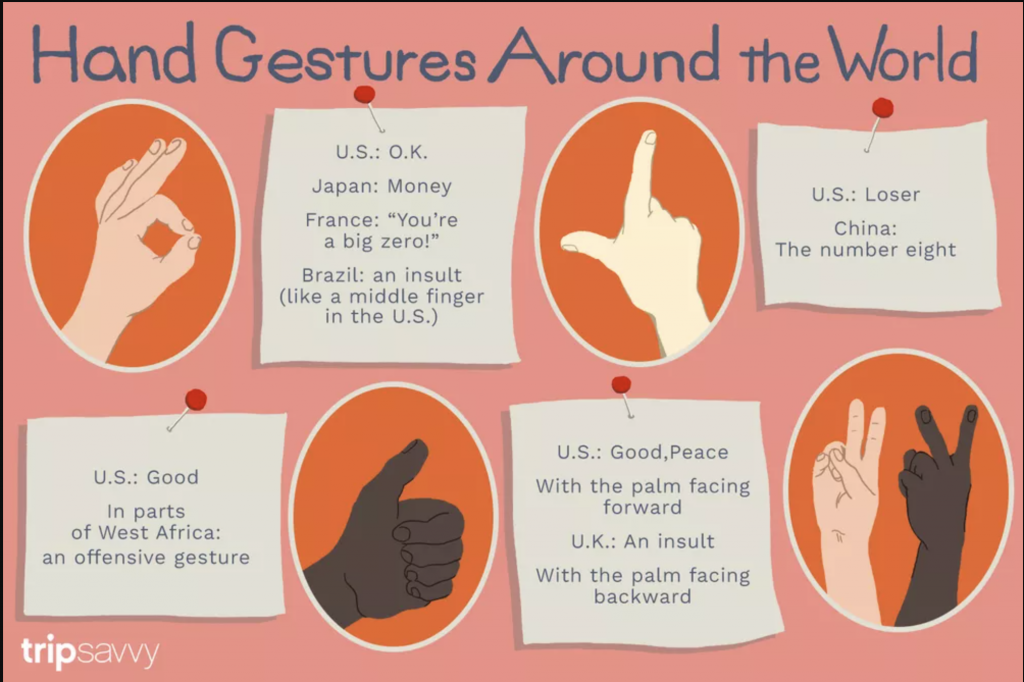
Semiotics
Semiotics is the study of signs and symbols, their use and interpretation. (Hosken n.d.) The problem with symbols and meaning is that the meaning we assign them is completely arbitrary. It is also open to change and culture shifts. Meanings can fall out of fashion, or be tainted by unintended associations. The swastika is a good example of this. It is such a simple graphical symbol and has been used by many cultures throughout history, as holy religious symbols in Buddhism, Hinduism and Jainism, or simply as a decorative motif or symbol of purity and good luck in many Western cultures. Due to the use of the right-facing swastika by the Nazi party, its meaning has been severely damaged and twisted into a symbol of hatred and fascism. In most parts of the Western world you would assume a swastika painted on someone’s door is a hate-crime, rather than a decoration celebrating a religious festival.
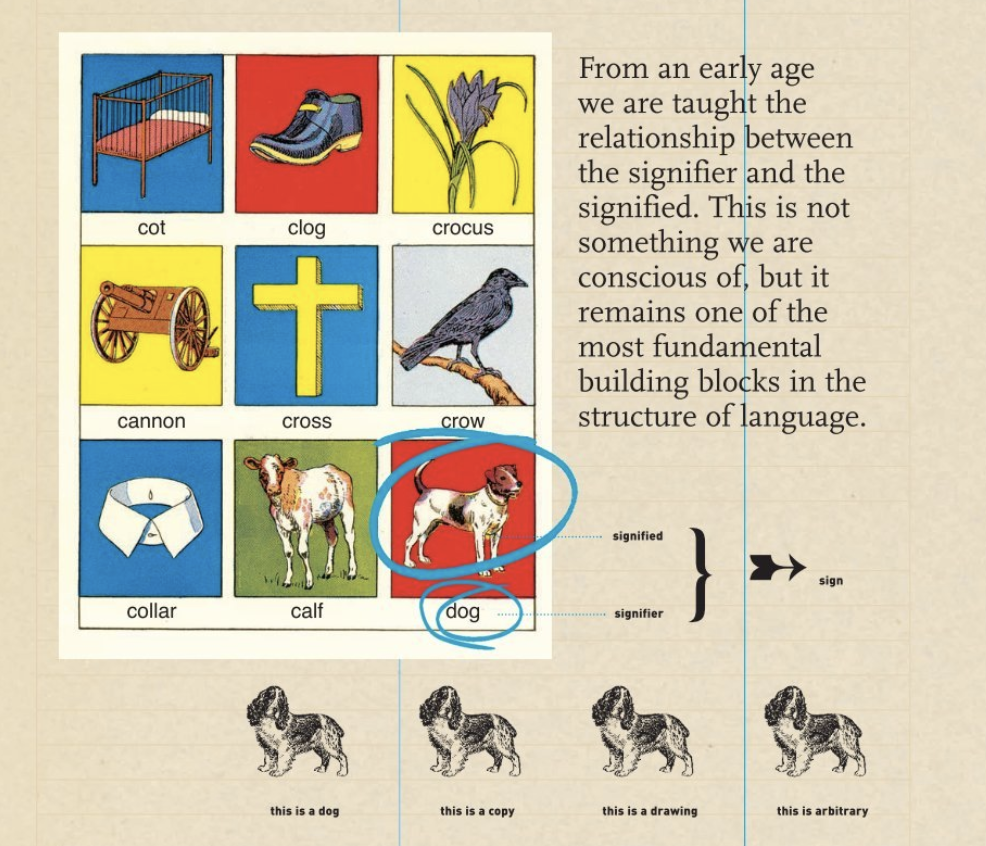
Signs
A sign is made up of the signified and the signifier. (Hosken n.d.) We are taught this concept from a very young age, linking language and visual representation – numbers and alphabets are incredibly strong memory objects, which once obtained are automatic and instantaneous.
Signifier
The item or thing that carries a message
Signified
Is the concept itself
There are three categories of signs:
Icon
Resembles the sign directly,
Index
Directly links the sign and the object
Symbol
Abstract sign that has no direct or inherit meaning, relies on culturally learned significance
We then also have the concepts of conventions, anchorage and relay.
Convention
A cultural agreement about a sign’s meaning – as symbolism is arbitrary, it is necessary to learn the conventional meanings. This is often picked up unconsciously.
Anchor
Text that reinforces the meaning of a sign, such as a caption, title or label
Relay
Text that alters or advances the meaning
HyperNormalisation
HyperNormalisation was incredibly depressing to watch. The main thrust of the documentary is that since the 1970’s, the world has been kept stable by politicians and corporations, using doublespeak and propaganda to create a “fake world”. World leaders have given up on the more complex ‘real world’, focusing only on what is easy to manipulate or hide.
The term hypernormalisation came from Alexei Yurchak, “Although any authoritative language, political or religious, contains many formulaic structures, clichéd “sound bites,” and ritualized features— and is therefore highly citational—the new authoritative language of late socialism had acquired certain unique characteristics. This language had become what I term hypernormalized—that is, the process of its normalization did not simply affect all levels of linguistic, textual, and narrative structure but also became an end in itself, resulting in fixed and cumbersome forms of language that were often neither interpreted nor easily interpretable at the level of constative meaning. This shift to the hypernormalized language in which the constative dimension was increasingly being unanchored is key for our understanding of late socialism.” (Yurchak 2006)
Language became completely unfixed from meaning, the consequences of printing or publishing the wrong thing were dire, so writing tended to be done by committee with only their own previous writing or other approved writing to refer to. As a result speeches and publications became set, safe, and unmovable. It did not matter if they were true, it only mattered that they sounded right.
The film also charted the rise of Donald Trump, which was very unsettling to watch given what has ended up happening since the documentary was created in 2016.
Workshop challenge
Case Study 1: Take one story to see how it is reported globally. Collect three versions of the same story from three different countries. How is it reported? Headline? Text? Unpacking meaning and distorting meaning.
Case Study 2: Take a brand and look at how it is delivered in different countries, e.g. alcohol, tobacco, transport, cars. Is it symbolised in a different way? Why might colour or typeface have been changed? Does it work at a local level and does it work at a global level?
Case Study 1
For the first case study I looked at Scotland becoming the first country to provide period products for free. I looked at coverage in The Guardian, NPR, Aljazeera and also Fox News. All of the coverage was positive, but I broke down some key aspects.
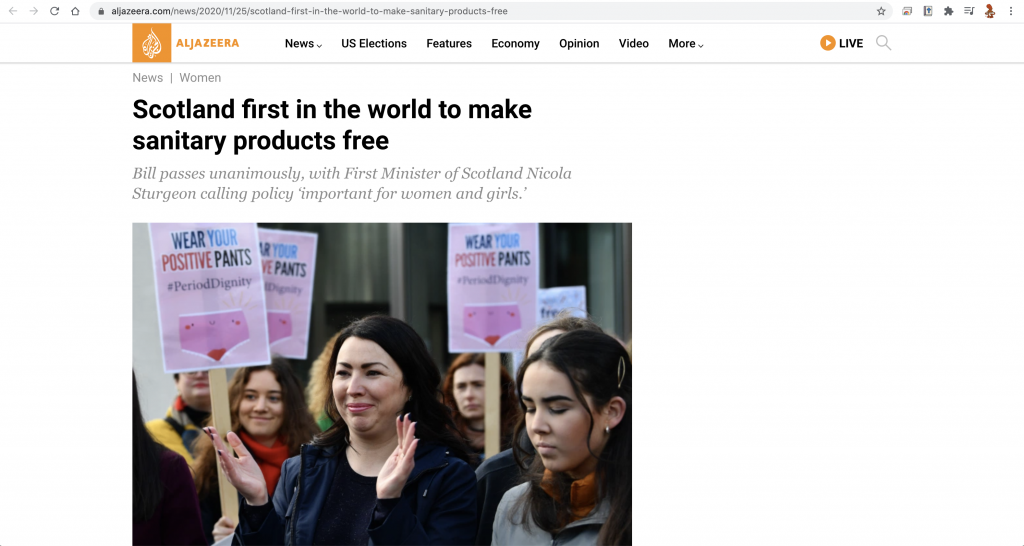
Aljazeera
Headline: Scotland first in the world to make sanitary products free
Subheading: Bill passes unanimously, with First Minister of Scotland Nicola Sturgeon calling policy ‘important for women and girls.’
Featured Image: Monica Lennon joins campaigners and activists during a rally outside the Scottish Parliament in support of the Scottish Governments Support For Period Products Bill on February 25, 2020 in Edinburgh, Scotland [Jeff J Mitchell/Getty Images]
Source: REUTERS
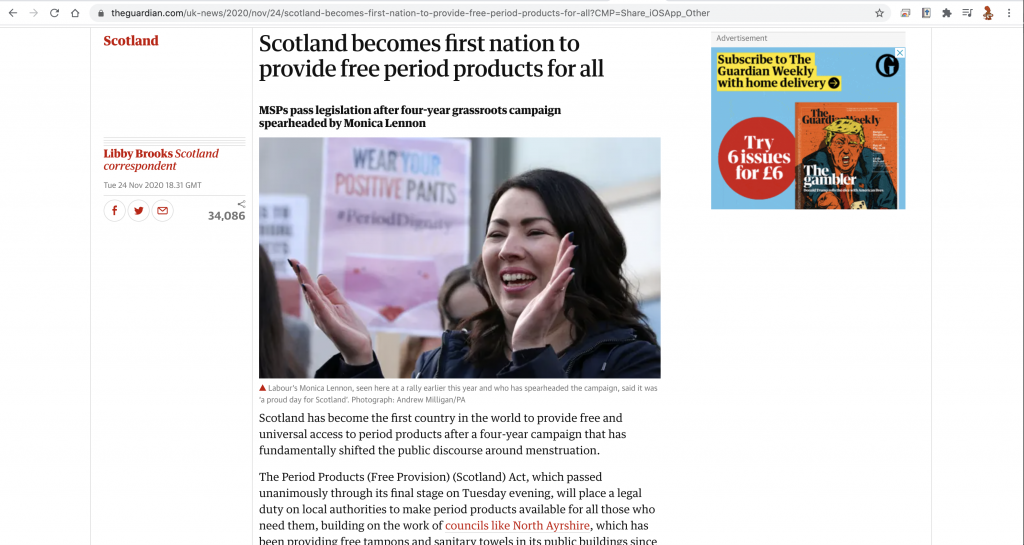
The Guardian
Headline: Scotland becomes first nation to provide free period products for all
Subheading: MSPs pass legislation after four-year grassroots campaign spearheaded by Monica Lennon
Featured Image: Labour’s Monica Lennon, seen here at a rally earlier this year and who has spearheaded the campaign, said it was ‘a proud day for Scotland’. Photograph: Andrew Milligan/PA
Source: Libby Brooks Scotland correspondent
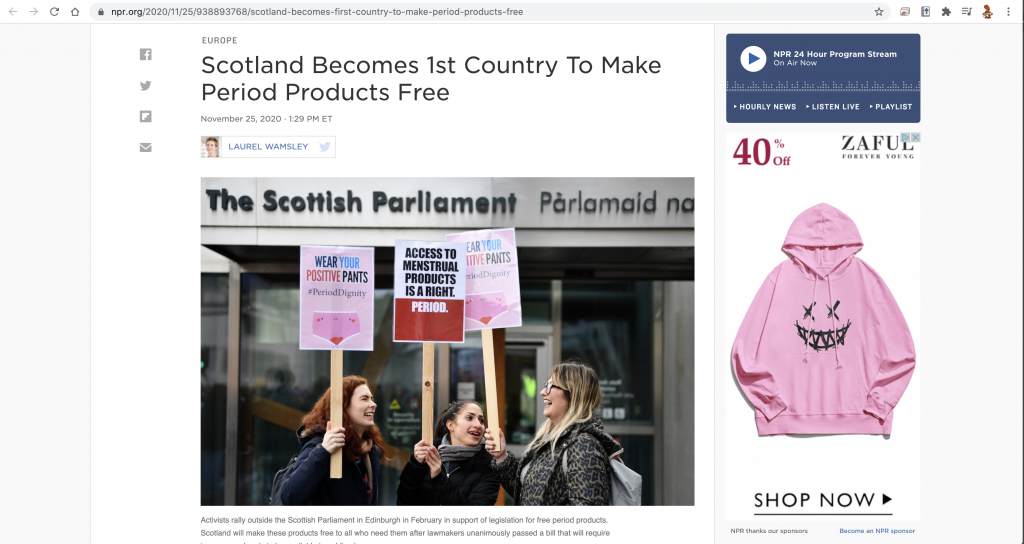
NPR
Headline: Scotland Becomes 1st Country To Make Period Products Free
Subheading: None
Featured Image: Activists rally outside the Scottish Parliament in Edinburgh in February in support of legislation for free period products. Scotland will make these products free to all who need them after lawmakers unanimously passed a bill that will require tampons and pads to be available in public places. Jeff J Mitchell/Getty Images
Source: Laurel Wamsley
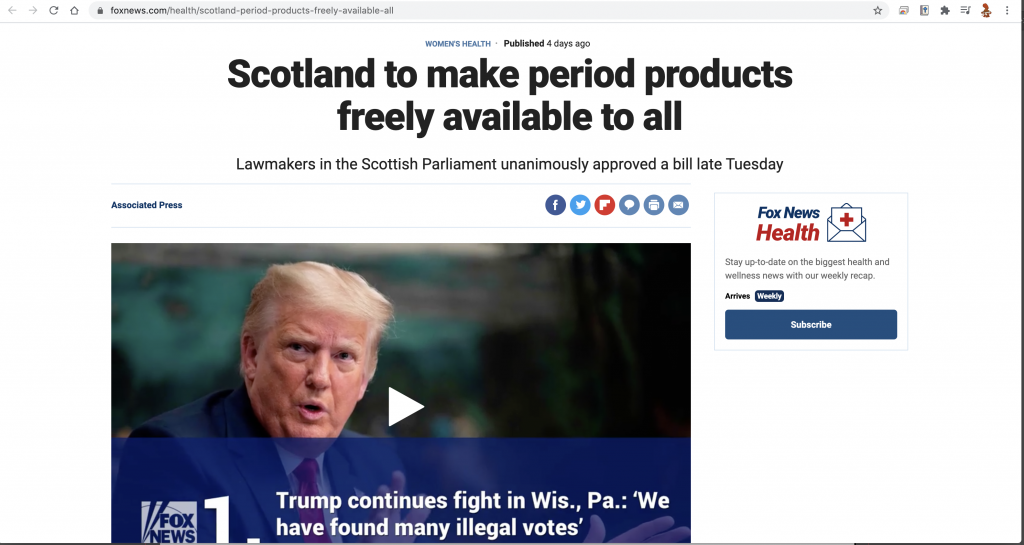
Fox News
Headline: Scotland to make period products freely available to all
Subheading: Lawmakers in the Scottish Parliament unanimously approved a bill late Tuesday
Featured Image: Bizarrely, a video of Donald Trump, followed by a stock image of period products
Source: Associated Press
The Guardian’s coverage was the most in depth, which makes sense as it is a local story covered by a local correspondent. NPR had a positive tone, and provided links to previous coverage. Aljazeera and Fox News both used news agency stories rather than a staff writer, but Aljazeera set it respectfully and sourced appropriate images. Fox News was baffling. Not only did they use a video of Donald Trump as the leading image (n.b. it appears they have rolling top news footage in that space) the story itself was hidden several pages deep in the Women’s Health section, which is not even included in the footer.

As well as the lack of appropriate images, Fox News also distractingly scatters large bold links to other stories directly in the middle of the article text. Upon scrolling down, the top video jumps to the bottom of your view and autoplays. It is almost as if they are purposefully trying to distract you and keep you from reading the article.

Both NPR and The Guardian included relevant links to previous coverage, source material or resources. Aljazeera included one section of related articles, but they were more subtle and kept to a single area. All of the sites included advertisements and side bars, some included animation, but only Fox News included a loud autoplay feature that followed you as you scrolled.
Not all news sources are neutral, and even with such a non-controversial story, there are marked differences in how the story was presented and what value was given to it. The differences were not between countries, rather between more impartial news sources and more partisan sources. Fox News is a notoriously unbalanced and inaccurate news source, which feeds into the issues covered in HyperNormalisation.
Case Study 2
Kentucky Fried Chicken is one of the biggest fast food brands in the world. Their branding and imagery are incredibly consistent, with the exception of KFC in Quebec, where it was forced to change the name to Poulet Frit Kentucky in keeping with language laws for signage. Even in cultures where the Latin alphabet is not used, the KFC logo is still in use and instantly recognisable. KFC has reached a level of world-wide brand consciousness that the letterforms themselves have their own cultural significance isolated from the meanings of the letters.
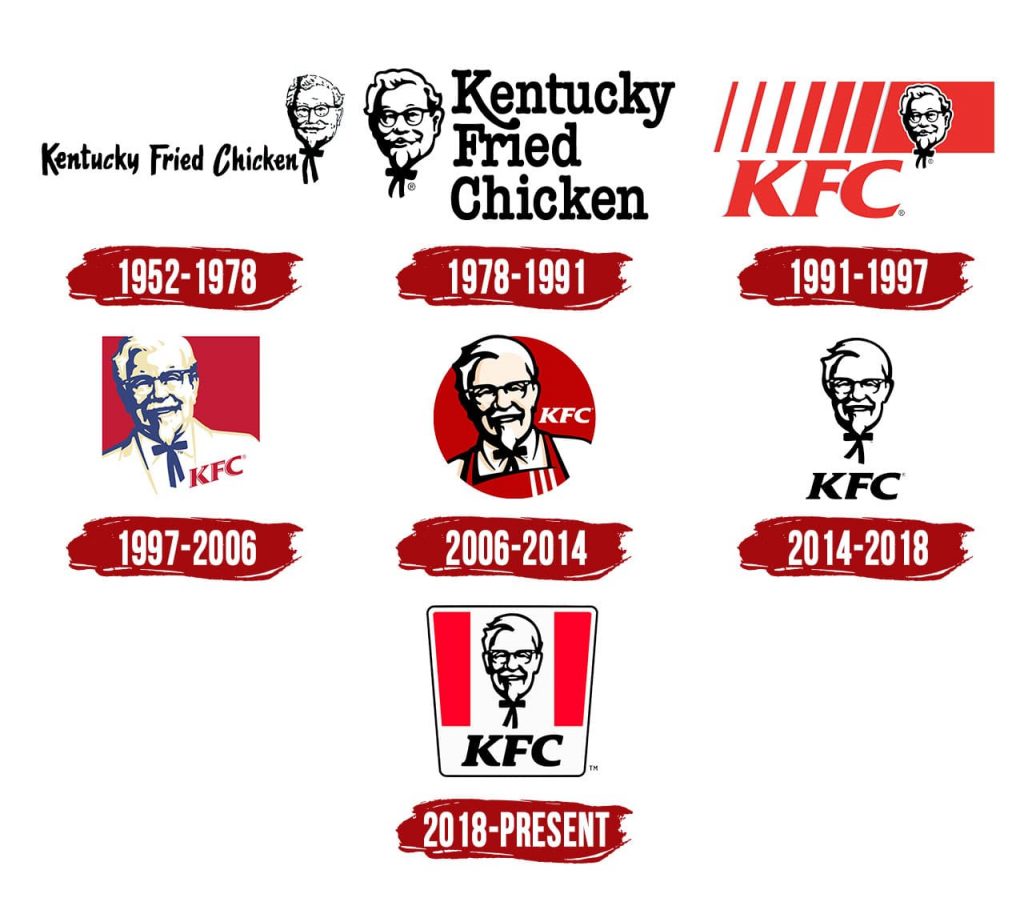
Although not current, this copy of the brand guidelines from 2006 shows how thoroughly they document the correct use of the logotypes, lettertypes, brand colours, placement and production values.
I visited KFC’s websites in several countries, and while visually branded similarly, they were each quite different.
Where KFC is very strong is optimising local offers to the surrounding culture. They are well known for serving local specialities and common foods with a twist. Franchises seem to have more freedom and flexibility to adapt to local tastes and the dominant food culture. It has a heavy market share in Asian countries, being the most popular Western fast food option in China, with over 5,000 locations. (KFC 2020)
TheTravel.com has collected 25 of the most interesting menu items from different countries, including shrimp burgers in China, Okonomiyaki chicken in Hong Kong, and rice congee and egg tarts throughout many Asian countries. One particularly monstrous example is the double down dog in the Philippines, an unholy mix of a hot dog surrounded by a chicken patty shaped as a bun. Some of these options will be short-lived novelties, released occasionally as marketing and pr stunts, market tests or seasonal offerings, but each country has an optimised menu depending on the food culture of that country and what target market is appealed to.
KFC are also very open to interesting collaborations and marketing campaigns, such as these chicken bucket clogs with Crocs.
The clogs feature chicken scented charms and were unveiled at Fashion week in February 2020, they sold out within 30 minutes of release. (Jiang 2020)
In 2019 they released I Love You, Colonel Sanders! A Finger Lickin’ Good Dating Simulator, a parody of Japanese dating simulators featuring anime tropes and a redesigned bishonen Colonel Sanders. The game is available for free on Steam, so I downloaded it and gave it a whirl. While being an obvious marketing vehicle, it was also charming, bizarre and funny. I’m no expert in the dating simulation genre, and it has received criticism from serious game experts, but for a casual user it was an enjoyable experience.
These marketing stunts don’t always land. In 2017 KFC produced a romance novel called Tender Wings of Desire, which was roundly slated.
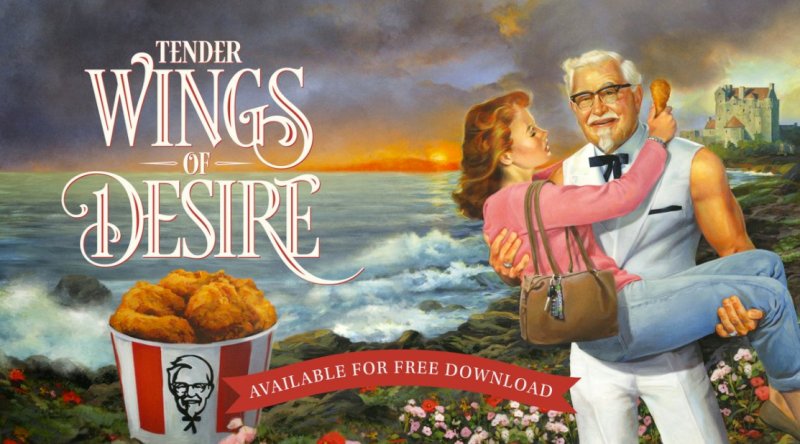
Let’s hope that the newest effort, A Recipe for Seduction, a Lifetime mini movie premiering just in time for Christmas gets the tone right. Starring Mario Lopez as Colonel Sanders and featuring a murderous spurned fiancé, a scheming mother, and 11 secret herbs and spices, they have leaned hard into the sensationalist schlocky tropes of Lifetime movies.
Christmas and KFC
KFC is well known for promotional Christmas campaigns, such as the chicken themed jumpers available in the UK.
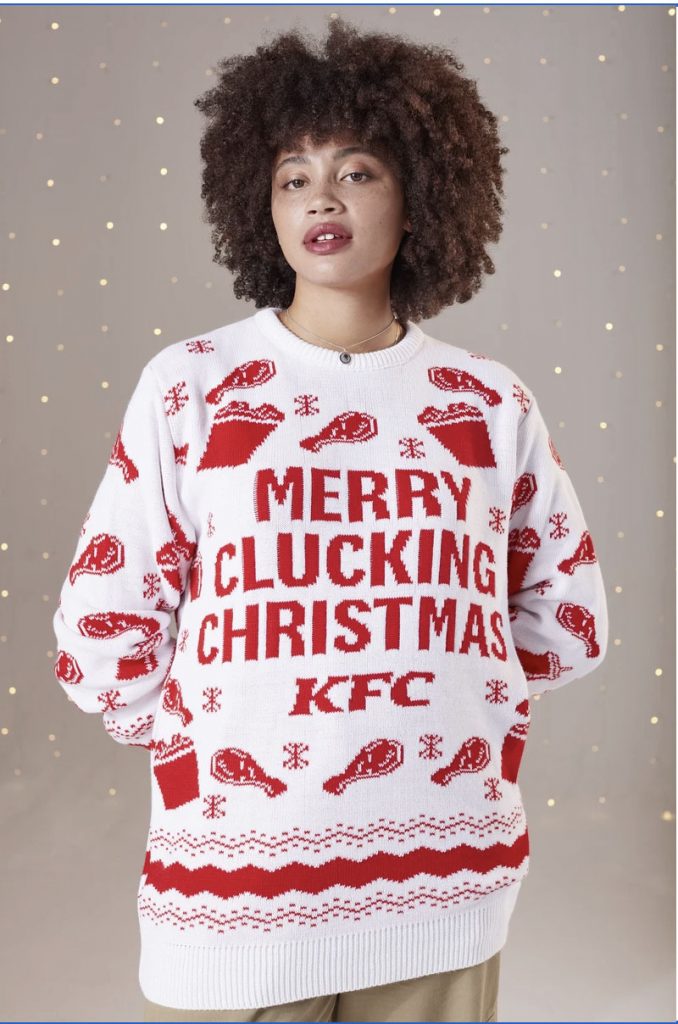
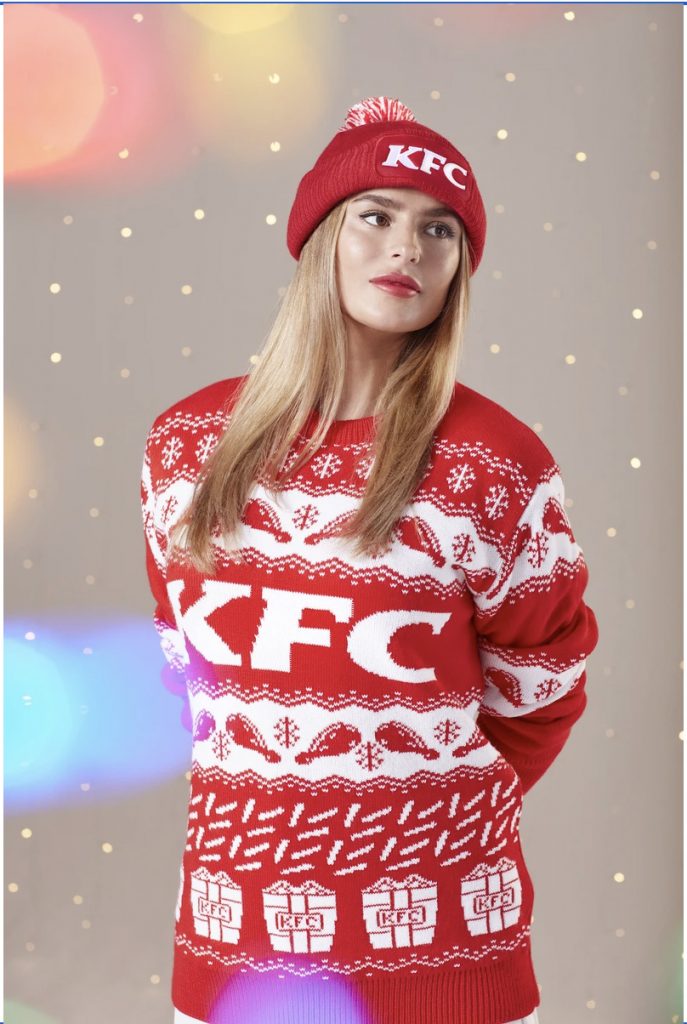
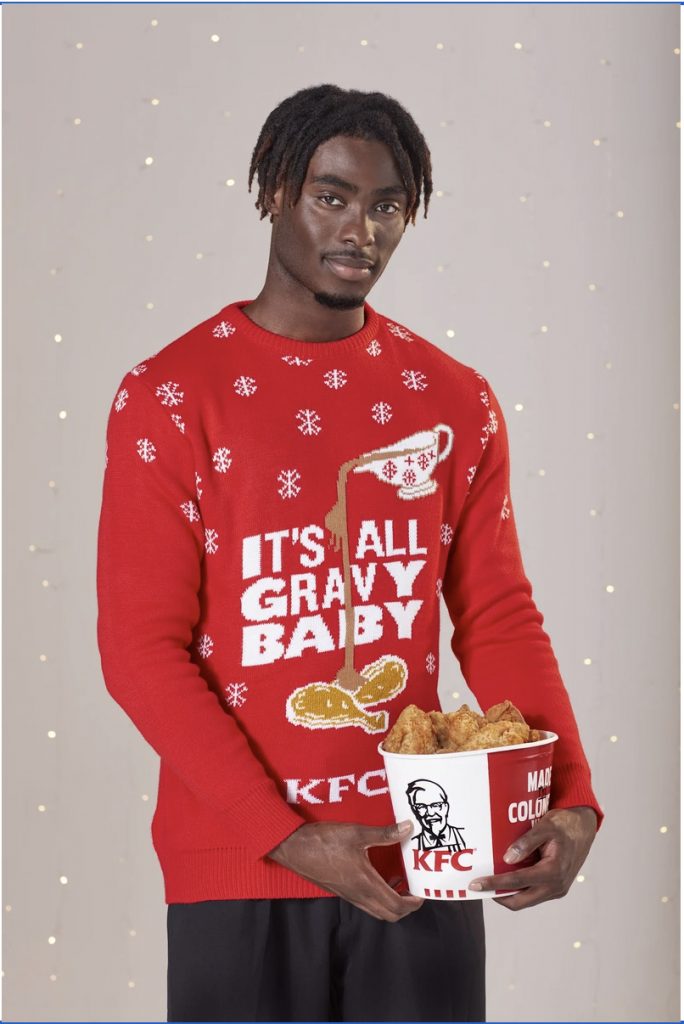
In Japan, however, KFC has become synonymous with Christmas. Christmas in Japan is a fairly recent phenomenon, only popularly celebrated for the last few decades. In 1974 KFC launched a Christmas campaign with the slogan “Kentucky for Christmas” that has been so popular it is now the de facto official Christmas dinner in Japan. The “party barrels” include a bucket of chicken, a cake, various sides, and a commemorative decorative plate. Other options are available, including a luxury tier of specially roasted whole birds. Millions of people pre-order these festive meals, sometimes months in advance, and queue for hours to pick them up. It is also a popular place for a romantic Christmas eve dinner for couples. As there were no pre-existing Christmas traditions in Japan, KFC has become part of the new national tradition.
“Dr. Nathan Hopson, professor of Japanese history at the University of Nagoya, writes that in the same way that some young Japanese couples long for Christian-style “chapel” weddings, “Christmas has an association with a kind of exotic and romantic view of ‘the West’ that is entirely divorced from history, religion, or any other inconvenient facts.” He also points out that because so few, if any, Japanese homes feature ovens, buying take-out chicken fits the Japanese mold: “Christmas cakes and KFC make sense both in terms of the constraints of the typical Japanese home and as empty symbols—like Christmas itself—into which everyone can pour their own hopes and dreams.” (Fater 2019)
In spite of concerns over tainted meat and animal welfare, KFC has managed to stay on top of the fast food world. Clever marketing and sensitivity to local tastes has proved a winning strategy. A strong visual identity paired with a flexible approach to store design, menu offerings, and local products has resulted in excellent international brand perception.
Workshop challenge
I chose to focus on the Christmas aspects of the KFC research I had done. I created a Christmas tree out of buckets of chicken, and set my headline in a hand lettering style typeface commonly used for Christmas cards. I used the official brand colours for the background and set the article type in a clean serifed font.
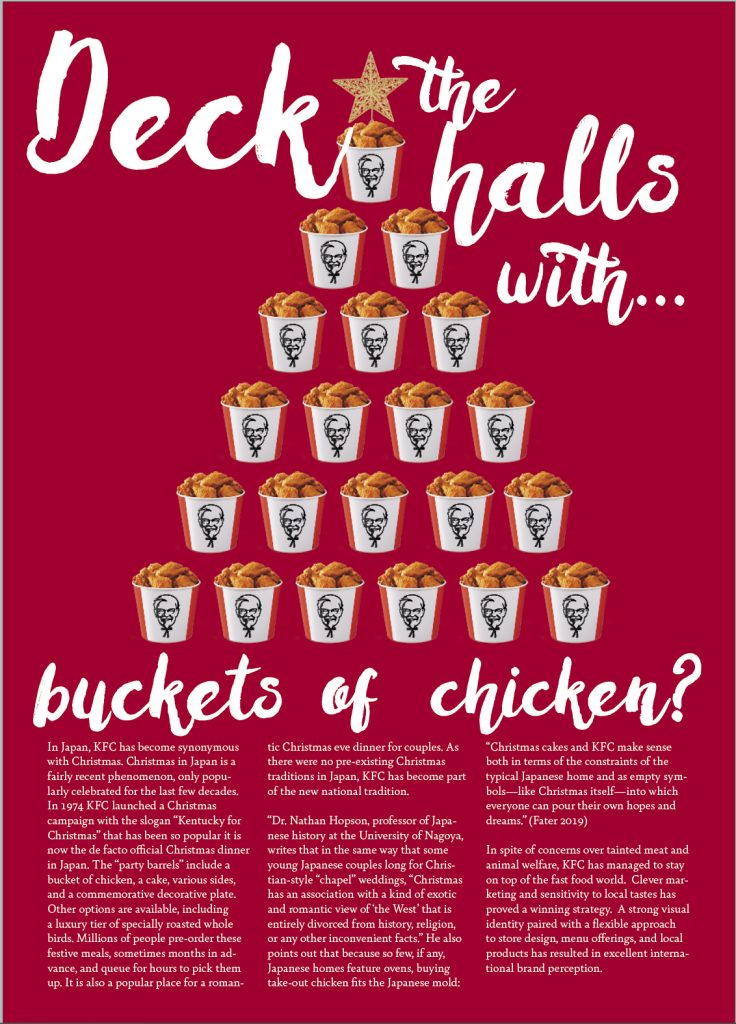
This was starting to develop into something interesting, but I did not like large empty spaces on the left side of the header. I had tried several options for the text, but nothing had the impact I was looking for. I wanted to add texture and visual interest, so I took a chicken drumstick and turned it into a snowflake. It didn’t quite read as a snowflake, so I layered it over a more natural looking snowflake, trying different combinations and textures before subtracting the inside of the drumstick but leaving a thick outline behind.



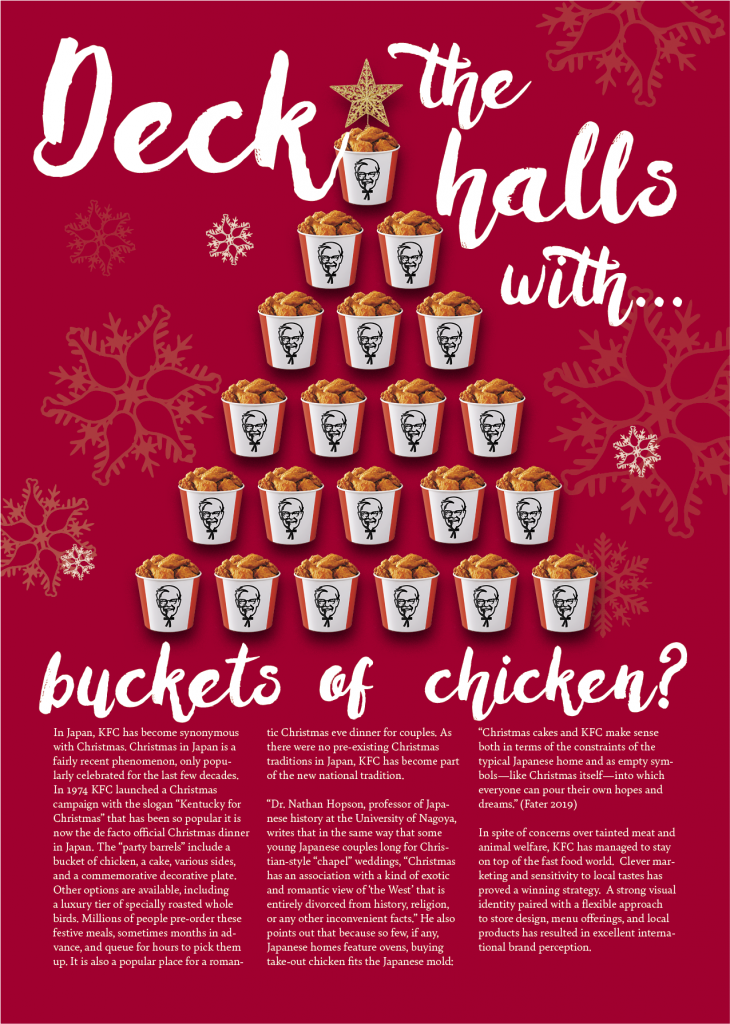
This gave the background more texture and depth. By using a visual pun and Christmas imagery I emphasised the subject matter, and the smaller white chicken snowflakes lead the eye on a path down to the article. Although I’m not a huge fan of throwing drop shadows around willy-nilly, a drop shadow on the chicken buckets draws more attention to them and anchors them in place.
Summary
As someone who has moved many times in my life before emigrating to another continent, I was very aware of differences in branding around the world. America is such a large country that there are even regional differences in the same brands. There is quite often an East/West coast divide, as well as even smaller regional variations. For example Helmann’s mayonnaise is known as Helmann’s on the East coast of America, and worldwide. On the West coast, however, it is called Best Foods.
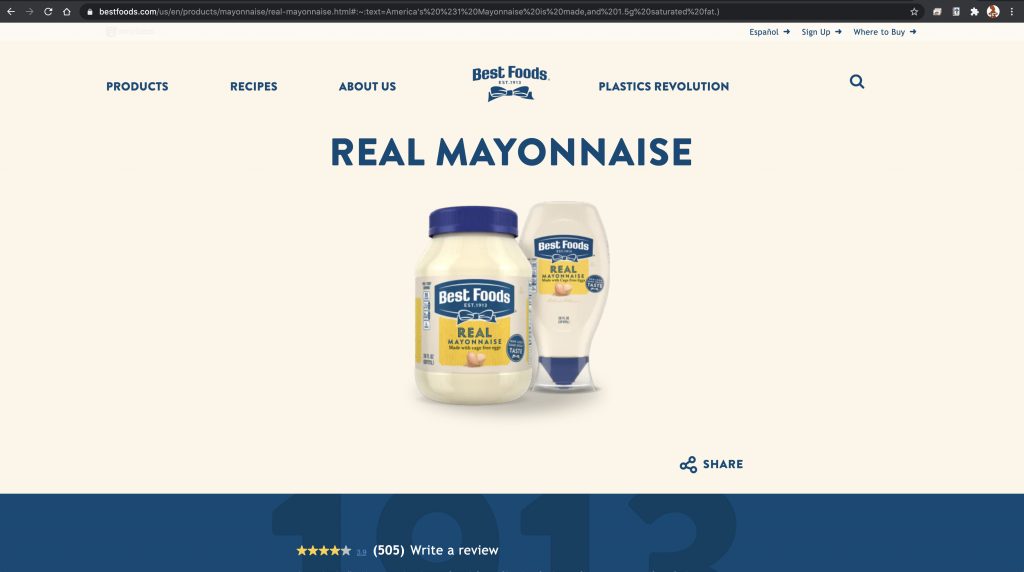
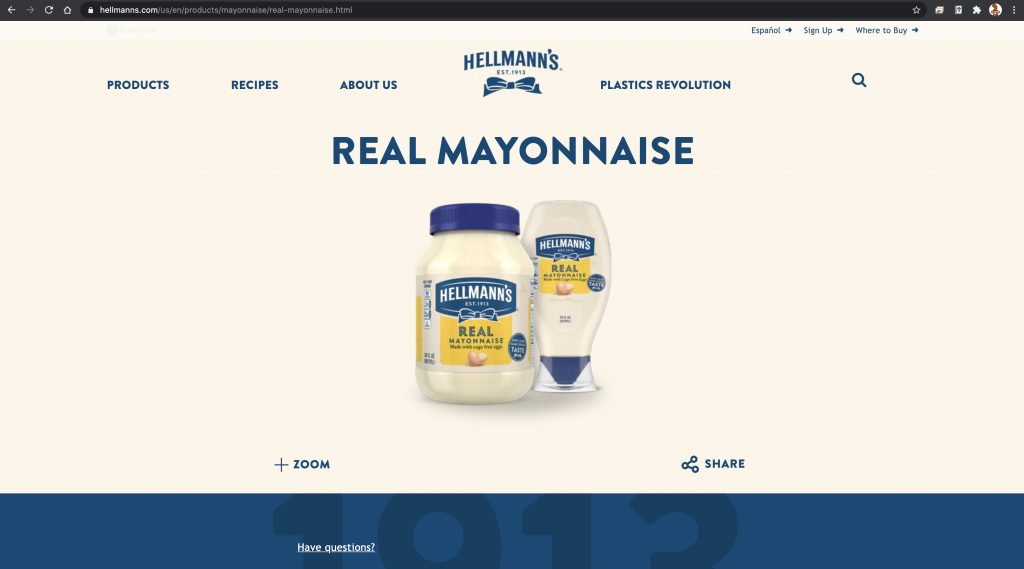
Their websites are identical, the branding (apart from the logo) is identical, the product is the same but due to complicated corporate history, the divide is deeply engrained. I thought this was interesting and tied back to the lecture materials. People have developed such strong emotional reactions and brand loyalty, that even given the same products, the same logos, icons, typography and general look and feel, they will still insist that their version is the superior.
Terrifyingly the power of branding is being manipulated for political means, as doublespeak and fake news is on the rise. We can’t even depend on evidence based facts anymore. We all rely on a shared culturally learned significance to signs and symbols, a majority of which were so naturally and gradually learned we weren’t aware of it. Design can communicate on many different levels at once, and it is incredibly important to be mindful of what you are communicating. Cultural context is also extremely important and can be the difference between a failed project and a success.
References
ASSOCIATED PRESS. 2020. “Scotland to Make Period Products Freely Available to All.” Fox News [online]. Available at: https://www.foxnews.com/health/scotland-period-products-freely-available-all [accessed 30 Nov 2020].
BROOKS, Libby. 2020. “Scotland Becomes First Nation to Provide Free Period Products for All.” The Guardian [online]. Available at: https://www.theguardian.com/uk-news/2020/nov/24/scotland-becomes-first-nation-to-provide-free-period-products-for-all?CMP=Share_iOSApp_Other [accessed 30 Nov 2020].
CORNELIUS, Ian. 2018. “25 Of The Most Unique KFC Menu Items From Around The World.” TheTravel [online]. Available at: https://www.thetravel.com/25-of-the-most-unique-kfc-menu-items-from-around-the-world/ [accessed 5 Dec 2020].
DUNNE, Anthony. 2019. “Anthony Dunne & Fiona Raby on Speculative Design.” YouTube [online]. Available at: https://youtu.be/67ZsArFWDZc [accessed 10 Dec 2020].
EDWARDS, Susanna and THOMAS, Patrick. 2020. Week 11 Interview [lecture]. GDE710 for MA Graphic Design. Falmouth: Falmouth University 2020 [Accessed 27 Nov 2020]
FATER, Luke. 2019. “How a White Lie Gave Japan KFC for Christmas.” Atlas Obscura [online]. Available at: https://www.atlasobscura.com/articles/what-is-japanese-christmas [accessed 7 Dec 2020].
FINN, Tom. 2020. Week 11 Guest Lecture Case Study [lecture]. GDE710 for MA Graphic Design. Falmouth: Falmouth University 2020 [Accessed 27 Nov 2020]
HOSKEN, Martin. 2020. Week 11 Guest Lecture Symbolism and Semiotics [lecture]. GDE710 for MA Graphic Design. Falmouth: Falmouth University 2020 [Accessed 27 Nov 2020]
“Japanese KFC Christmas Commercial – YouTube.” 2020. www.youtube.com [online]. Available at: https://youtu.be/umHfb1JHovA [accessed 7 Dec 2020].
JAZEERA, Al. 2020. “Scotland First in the World to Make Sanitary Products Free.” Aljazeera.com [online]. Available at: https://www.aljazeera.com/news/2020/11/25/scotland-first-in-the-world-to-make-sanitary-products-free [accessed 30 Nov 2020].
JIANG, Irene. 2020. “The KFC Crocs Collab Sold out Half an Hour after Their Launch, and Jilted Fans Are Angry.” Business Insider [online]. Available at: https://www.businessinsider.com/kfc-crocs-sold-out-less-than-half-an-hour-after-launch-2020-7?r=US&IR=T [accessed 6 Dec 2020].
KFC. 2019. “KFC | I Love You, Colonel Sanders! A Finger Lickin’ Good Dating Simulator | Available Now!” YouTube. Available at: https://www.youtube.com/watch?v=sJbF6k-e4-s [accessed 5 Dec 2020].
KFC. 2020. Kfc.com [online]. Available at: https://global.kfc.com/stories/how-kentucky-for-christmas-began-in-japan [accessed 5 Dec 2020].
KFC. 2020. “KFC x Crocs. Not for Human Consumption. – YouTube.” www.youtube.com [online]. Available at: https://www.youtube.com/watch?v=GHkLo9_4oyQ [accessed 6 Dec 2020].
KFC AND CROCS. 2020. “KFC® x CrocsTM | CrocsTM Official Site.” www.crocs.com [online]. Available at: https://www.crocs.com/KFC.html [accessed 6 Dec 2020].
“KFC Review Around the World – Around the World Travels.” 2010. Aroundtheworldtravels.co.uk [online]. Available at: https://aroundtheworldtravels.co.uk/food-around-world/kfc-review-around-the-world/ [accessed 4 Dec 2020].
LEBRUN, Maxime. n.d. KFC. Available at: https://unsplash.com/photos/HqYWQo7l49w.
LOGOS WORLD. 2020. “KFC Logo | The Most Famous Brands and Company Logos in the World.” Logos-world.net [online]. Available at: https://logos-world.net/kfc-logo/ [accessed 5 Dec 2020].
“Scotland Becomes 1st Country To Make Period Products Free.” 2020. NPR.org [online]. Available at: https://www.npr.org/2020/11/25/938893768/scotland-becomes-first-country-to-make-period-products-free [accessed 30 Nov 2020].
TripSavvy / Jaime Knoth. n.d. Hand Gestures Around the World. Available at: https://www.tripsavvy.com/thmb/_sHqDcRcQlBgIVYn6Qgaoijrgso=/1000×0/filters:no_upscale():max_bytes(150000):strip_icc():format(webp)/hand-gestures-with-more-then-one-meaning-3149620-final-5db392473a944d11b2f7999269add9d3.png.
YURCHAK, Alexei. 2006. Everything Was Forever, until It Was No More : The Last Soviet Generation. Princeton, Nj: Princeton University Press.

